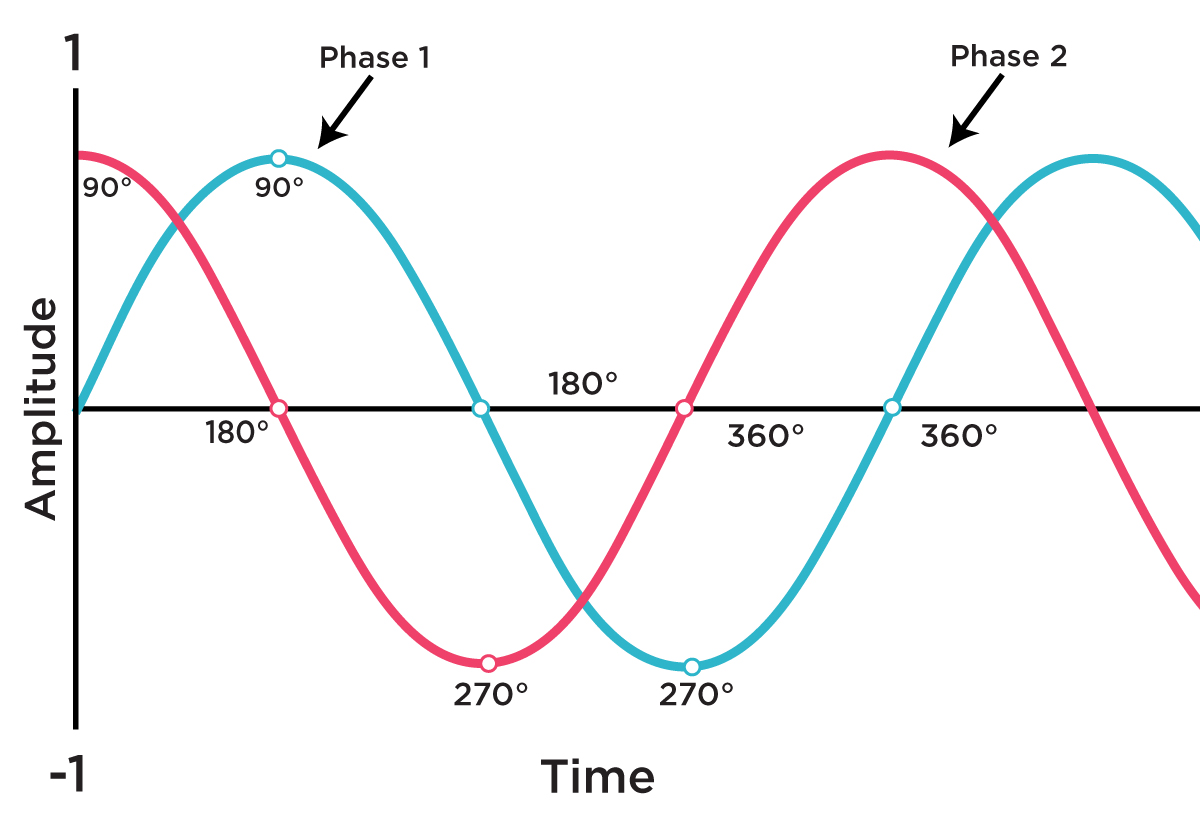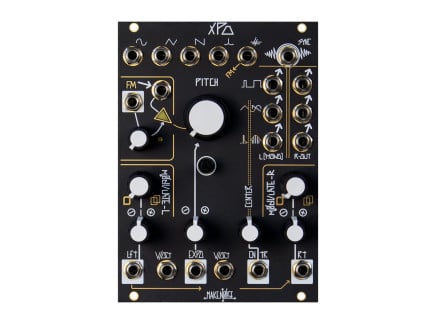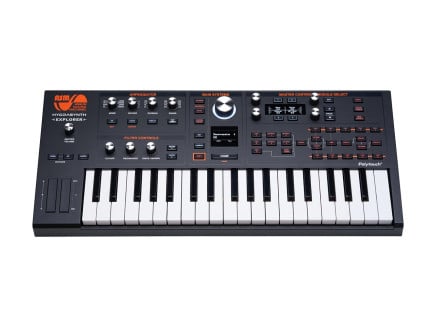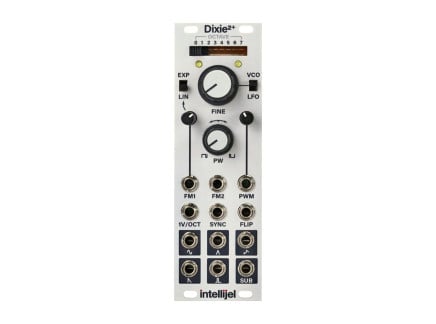Oscillator sync: you've probably seen it as an option on your synth, whether you're using software synthesizers, keyboard synths, or Eurorack modular gear. If you've experimented with it, you're probably familiar with some of the types of sounds it can produce: metallic sweeping effects, fractal-like distortion tones, odd pitch effects, and more.
But what is oscillator sync? In Wes's video above, he demonstrates hard sync using two Intellijel Dixie 2+ oscillators—but in the following text, we'll discuss what sync has, how it works, how you can use it, and a couple of different varieties of sync you're likely to find as you venture through the world of synthesis.
It's Just a Phase: Oscillator Phase Explained
Before discussing sync, it's important we establish a basic understanding of phase. So, let's work toward establishing a definition of phase as pertains to synthesizer oscillators.
If you're familiar with the basics of synthesizer oscillators, you're probably familiar with various common waveforms, like sine, saw, square, or triangle wave shapes. These are commonly used as the building blocks of synthesized sound, providing a basic timbre that you can further sculpt with filters, amplifiers, or other processors in order to create the sound you desire. Each of these shapes has a very different sound—and these distinct tone colors are the direct result of the shape the waveform takes over time. (Check our our dedicated article about oscillator waveshapes for an idea of how this all works!)
Of course, we know that varying the rate of an oscillation—that is, the number of cycles through the shape that occur within a specific timeframe—will affect our perception of its pitch. The higher the frequency, the higher the pitch.

While frequency determines the number of cycles per second, phase is something else entirely: it's a way of establishing where within a waveform's shape you currently are at a specific moment in time. Phase is defined in degrees, with 0 degrees (or 360 degrees) representing the "start" of a waveform, 180 degrees representing the "midpoint" of a waveform, etc. (See the diagram above for a demonstration of relative phase of two unsynchronized sine oscillators.)
You might have heard of phase modulation, a technique where you can create a wide range of effects by continuously altering an oscillator's phase—but today, we're going to talk about a considerably more common phase-related trick that has been part of synthesizers since their very beginning: sync.
What is Oscillator Sync?
So, let's answer the question: what is oscillator sync? Oscillator sync is a way of using one oscillator (commonly called the leader) to reset the phase of a second oscillator (commonly called the follower). In synthesizers with multiple oscillators, this is a common technique used to coerce more interesting sounds out of otherwise relatively simple oscillators. But how does it work? And when I say "reset the phase," what do I mean?
Let's first talk about the most common form of oscillator sync: hard sync. In hard sync, you typically use a signal with a hard rising edge (like a square wave or a saw wave) on your leading oscillator in order to tell your following oscillator when to reset its phase. By "reset," I mean that the leading oscillator tells your following oscillator when to re-start (i.e., when to reset to a phase of 0 degrees). If the following oscillator is only partway through its shape when it receives the "reset" signal, its output will be interrupted—producing a truncated version of its typical waveshape.
Usually, on a keyboard synth, sync between multiple oscillators will be accessible as a menu option, or as a dedicated button on the front panel—in which case, and appropriate shape from leading oscillator (saw, square, etc.) will be automatically connected to the following oscillator. In modular synthesizers, it's usually up to the user to physically make the connection, manually patching one oscillator's saw or square output to the sync input jack on the following oscillator.
Hard sync's truncation of the following oscillator has a couple of implications—partly impacting the following oscillator's pitch, and partly impacting its timbre. Let's talk through each part of this.
When the leading oscillator is higher in pitch than the following oscillator, this sync trick causes it to sound as if the following oscillator is tracking the leading oscillator's pitch: any changes to the leading oscillator's pitch will also cause a change in the following oscillator's pitch. This works because you're forcing the follower to reset in sync with the natural resets on the leading oscillator, locking them to the same frequency. This crude form of pitch tracking can be used in a pinch to cause multiple oscillators to track together—but it has a side effect.
The greater the difference in frequency between the two shapes, the more truncated the following oscillator's shape will become—ultimately impacting both its perceived timbre and its perceived loudness. As such, this method of oscillator synchronization isn't typically used for simple pitch tracking—after all, in most situations, you could just use the same keyboard, sequencer, or pitch control voltage to control both oscillators simultaneously anyway. So...what is oscillator sync actually good at?
Oscillator sync becomes particularly interesting once you start affecting the follower's frequency independently from the leader. By modulating the follower's frequency (with LFOs, envelopes, random voltages, etc.), you can achieve a crazy range of sounds—many of which became famous in synth lines from the 1980s (think of the Cars).
Usually, you would use a sequencer or keyboard to control both oscillators' frequencies, tune them to a desirable interval, sync the follower to the leader, and then apply an envelope or LFO to further modulate the following oscillator's pitch. In this patch, you can listen to either the follower alone, or a mix of the leader and follower, giving you a wide range of tones to experiment with. If the follower is tuned below the leader, you'll get sounds similar to pulse width modulation as you alter the follower's frequency—if you tune the follower above the leader, then you'll get more cycles before the follower resets, resulting in a brighter, more metallic sound (characteristic of how we often think of sync sounding).
As the distance between the follower and leader increases, the pitch tracking effect will seem to break down, and the follower's pitch will begin to seem more dominant than the leader...but you'll find plenty of great sounds in all ranges.
But What About Soft Sync?
Of course, hard sync isn't the only type of sync out there—there's a whole other world of techniques referred to as soft sync as well. Whereas hard sync forces a sudden reset in the oscillator's phase (resetting to 0 degrees), soft sync can work in a number of different ways.
Commonly, upon received the "reset" signal from the leader, soft sync causes the follower to change direction (often for as long as the leader is above or below a certain voltage "threshold"). Different forms of soft sync work differently, however—some invert the follower's shape for as long as the leader is beyond a certain voltage threshold; yet others work by causing the following oscillator to reset to different points in its phase. Moreover, because of its somewhat more squirrelly nature, soft sync often produces just as interesting/viable of effects when using "softer" waveforms from the leader as the sync source: if you have a modular system, experiment with using sines, triangles, and other shapes to sync your following oscillator.
Generally speaking, soft sync isn't great for pitch tracking...but it can provide a unique set of timbres when treated similarly to the hard sync sweeps described above. By modulating the follower's frequency independently from the leader, you can create sounds that seem to sporadically lock onto specific pitches in "sweet spots," but crackle and fall apart in between. Soft sync can be chaotic, slippery, or splintering in affect: it just depends on the specific synth or oscillator that you're using. They all have their own unique flavors of soft sync.
Syncing Your Teeth In
Of course, what we've described here is just scratching the surface! Many synthesizers implement sync in completely unique ways. Some oscillators can hard sync to smooth shapes. Some oscillators produce a sort of "medium" sync, where pitch sweeps seem to cause them to lock onto specific overtones/undertones of the leading oscillator (as in the Make Noise's XPO Stereo Prismatic Oscillator Eurorack module). And yet others offer variable sync response, allowing you to dial in the "tightness" of the sync effect, and others use peculiar phase modulation-like techniques to mimic sync and push it far beyond its typical timbres (the ASM Hydrasynth's Sync Mutant is an excellent example).
And of course, you can get even weirder! What would happen if you used the follower to frequency modulate the leader? What if you hard synced multiple oscillators in series? What if you mixed together two oscillators and used the mix to sync a third oscillator? What if you sent something other than an oscillator—maybe noise, maybe an external instrument?—into a Eurorack oscillator's Sync input?
Like any basic synthesis technique, there's more to sync than you might immediately realize. It's not all Cars leads and metallic growls...and with a bit of imagination, you still might discover something that no one has done before.
















